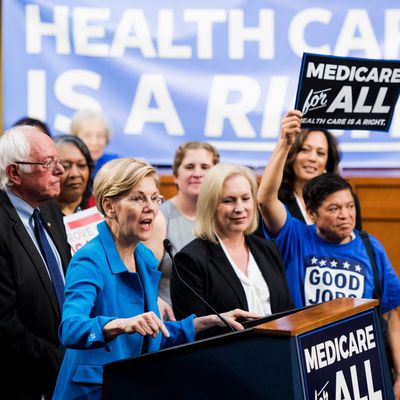
In 2018, Democratic candidates waded into hostile territory and flipped 40 House districts, many of them moderate or conservative in their makeup. In almost every instance, their formula centered on narrowing their target profile by avoiding controversial positions, and focusing obsessively on Republican weaknesses, primarily Donald Trump’s abuses of power and attempts to eliminate health insurance for millions of Americans.
The Democratic presidential field has largely abandoned that model. Working from the premise that the country largely agrees with them on everything, or that agreeing with the majority of voters on issues is not necessary to win, the campaign has proceeded in blissful unawareness of the extremely high chance that Trump will win again.
A new batch of swing state polls from the New York Times ought to deliver a bracing shock to Democrats. The polls find that, in six swing states — Michigan, Pennsylvania, Wisconsin, Florida, North Carolina, and Arizona — Trump is highly competitive. He trails Joe Biden there by the narrowest of margins, and leads Bernie Sanders and Elizabeth Warren.
Normally, it is a mistake to overreact to the findings of a single poll. In general, an outlier result should only marginally nudge our preexisting understanding of where public opinion stands. This case is different. To see why, you need to understand two interrelated flaws in the 2016 polling. First, they tended to under-sample white voters without college degrees. And this made them especially vulnerable to polling misses in a handful of states with disproportionately large numbers of white non-college voters. The Times found several months ago that Trump might well win 270 Electoral College votes even in the face of a larger national vote defeat than he suffered in 2016.
All this is to say that, if you’ve been relying on national polls for your picture of the race, you’re probably living in la-la land. However broadly unpopular Trump may be, at the moment he is right on the cusp of victory.
What about the fact Democrats crushed Trump’s party in the midterms? The new Times polling finds many of those voters are swinging back. Almost two-thirds of the people who supported Trump in 2016, and then a Democrat in the 2018 midterms, plan to vote for Trump again in 2020.
Perhaps some of that movement represents a desire by voters to check Trump’s power and restore divided government. But the poll contains substantial evidence that Trump’s party lost the midterms for the hoary yet true reason that Republicans took unpopular positions, especially on health care, and ceded the center. Rather than learn the lesson, Democrats instead appear intent on ceding it right back to them.
The “center,” of course, is a somewhat hazy concept, subject both to overinterpretation and misinterpretation. Capturing the center isn’t the only reason politicians win elections, and some policies that Washington elites consider “radical” are in fact popular. Nonetheless, it really is true that there are a bunch of persuadable voters who can be pushed away from a party based on their perception that it’s too radical.
And the Democratic presidential primary has been a disaster on this front. The debate has taken shape within a world formed by Twitter, in which the country is poised to leap into a new cultural and economic revolution, and even large chunks of the Democratic Party’s elected officials and voting base have fallen behind the times. As my colleague Ed Kilgore argues, the party’s left-wing intelligentsia have treated any appeals to voters in the center as a sign of being behind the times.
Biden’s paper-thin lead over Trump in the swing states is largely attributable to the perception that he is more moderate than Elizabeth Warren or Bernie Sanders. Three-quarters of those who would vote for Biden over Trump, but Trump over Warren, say they would prefer a more moderate Democratic nominee to a more liberal one, and a candidate who would find common ground with Republicans over one who would fight for a progressive agenda.
There are lots of Democrats who are trying to run moderate campaigns. But the new environment in which they’re running has made it difficult for any of them to break through. There are many reasons the party’s mainstream has failed to exert itself. Biden’s name recognition and association with the popular Obama administration has blotted out alternatives, and the sheer number of center-left candidates has made it hard for any non-Biden to gain traction. Candidates with strong profiles, like Cory Booker and Amy Klobuchar, have struggled to gain attention, and proven politicians like Michael Bennet and Steve Bullock have failed even to qualify for debates.
But in addition to those obstacles, they have all labored against the ingrained perception that the Democratic party has moved beyond Obama-like liberalism, and that incremental reform is timid and boring. The same dynamic was already beginning to form in 2016, though Hillary Clinton overcame it with a combination of name recognition and a series of leftward moves of her own to defuse progressive objections. Biden’s name brand has given him a head start with the half of the Democratic electorate that has moderate or conservative views. But it’s much harder for a newer moderate Democrat lacking that established identity to build a national constituency. The only avenue that has seemed to be open for a candidate to break into the top has been to excite activists, who are demanding positions far to the left of the median voter.
The primary has not doomed Democrats. Warren and Sanders are still close enough to Trump that they can compete, and new events, like a recession or another scandal, could erode Trump’s base. But the party should look at its position a year before the election with real fear. The party’s presidential field has lost the plot.






























